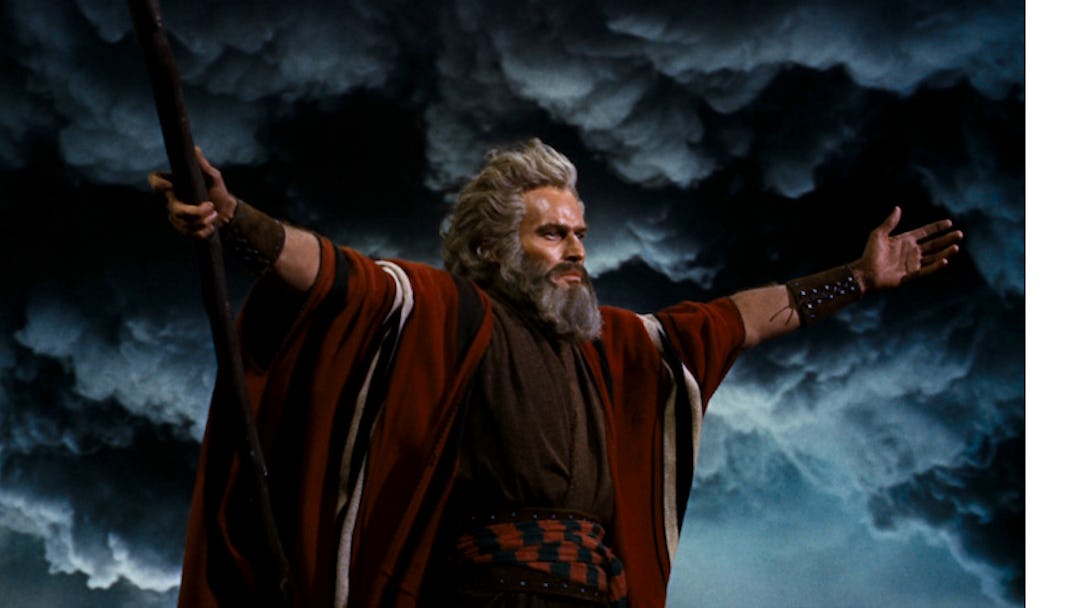Penny Lane’s Hail Satan?, out tomorrow in limited release, is a deftly funny and razor sharp documentary, detailing the rise of the Satanic Temple from a three-member publicity stunt to a 50,000-strong social movement (in about three years). Her presentation of their public campaigns for separation of church and state make for captivating, and occasionally infuriating, viewing. But one of the most fascinating pieces of the story is a movie trivia sidebar that sent this viewer scurrying to Google afterwards. Maybe it did the same for you, and if so, hello.
Much of the film’s running time is spent on the group’s battles with state legislatures in Oklahoma and Arkansas, whose state capitols are decorated with large monuments dedicated to the biblical Ten Commandments. The Satanic Temple (rightly) challenges the statues as endorsements of a specific set of religious beliefs in a public space, and offers up a compromise: placing, alongside the Commandment monument, a giant statue of the goat-heated Baphomet, their deity of choice.
Like anyone who’d casually followed this conflict when stories of protests, rallies, and destruction bubbled up, I assumed that at least part of the pro-monument sentiment was rooted in some kind of historical precedent; the monuments have been there forever, the thinking usually goes, so why not just leave well enough alone. (There’s plenty of this backwards thinking to go around.) So Hail Satan?’s little revelation hit this viewer like a bombshell. A great number of the monuments date back only to the 1950s – and they were originally placed there to promote a movie.
The movie, unsurprisingly, was The Ten Commandments, the religious epic from director Cecil B. DeMille – a man remembered less for his faith than his showmanship. When the project was announced in 1952, he already had an eye on the bottom line, per the New York Times :
Moses will be portrayed as a “handsome and fiery warrior prince,” according to DeMille. The producer, who long ago discovered that religion and sex properly combined are good box office insurance, added that “the romance of this magnificent physical specimen (Moses) who conquered the lands and armies to the south of Egypt, and who attracted the loves of the most exciting women of the day, is a powerful drama of one of the world’s great spiritual leaders.”
But DeMille didn’t just rely on Harlequin cover-esque quotes to sell his movie. He garnered plenty of free publicity with copy-friendly moves like joining with Ottawa’s government to stamp “Learn and Keep the 10 Commandments” on all letters that passed through their offices (the postal department insisted on modifying the original message, which instructed customers to “See, Learn, and Keep” the Commandments); distributor Paramount Pictures made a big show of earmarking a print of the final film for free screenings in prisons.
But the most elaborate stunt, by far, was the placement of tablet-style granite monuments in public spaces around the country. It was the brainchild of one E.J. Ruegemer, a Minnesota judge who (the story goes) once sentenced a young car thief to learn the Ten Commandments and decided such penetration of the Biblical do’s and don’t’s was just what the country needed. Ruegemer was a member of a Christian service group called the Fraternal Order of Eagles (or FOE for short), and the group’s original campaign distributed framed paper copies of the Commandments in Minnesota schools and courthouses.
But when Reugemer caught wind of DeMille’s film, then still in production, he saw a mutually advantageous relationship. The filmmaker would help the FOE raise funds to construct the granite monuments, which would be styled after the Commandment tablets in the movie. When the monuments were ready for placement – timed, as closely as possible, to the release of DeMille’s costly movie – representatives of the film, including stars Charlton Heston and Yul Brener and the director himself, would participate in the unveiling and dedication ceremonies. The star power would compel local press coverage, which would in turn raise the organization’s profile and assist in funding for further displays.
In all, more than 150 monuments were constructed and dedicated in 34 states and Canada; the campaign reached its peak around the time of the film’s release in 1956. The director needed all the help he could get – at $13.5 million, it was the most expensive movie made to that point – but the promotion paid off with a spectacular $65 million box office, making it one of the ten highest-grossing movies of all time (after adjustment for inflation). And the film’s status as an Easter weekend television perennial meant it never disappeared from the public eye, and neither did the FOE, which continued to place the promotional monuments around the country well into the second half of the century.
Amusingly enough, the monuments’ true origins were revealed when it was convenient for their defenders. In 2005, when the U.S. Supreme Court took up the cases of Ten Commandment monuments in Kentucky and Texas, pro-monument attorney Jay Sekulow argued that the religious separation question was irrelevant to the debate – because by promoting DeMille’s film, the monuments were serving an economic and thus secular purpose.
As noted in Hail Satan?, the Arkansas State Capitol monument targeted by the Satanic Temple not one of the DeMille monuments – it was built and dedicated in 2017. Within 24 hours of its unveiling, an angry citizen plowed into the monument with his Dodge Dart, turning it to rubble, and thus funds had to be raised to build it again. The primary donor, with a $25,000 contribution, was PureFlix Entertainment, a producer and distributor of “Christ centered movies” (including the God’s Not Dead series), dedicated to influencing “the global culture for Christ through media.” If nothing else, the monuments present a model of consistency: once a movie billboard, always a movie billboard.
